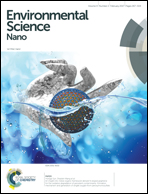Concurrent filtration and inactivation of bacteria using poly(vinyl alcohol-co-ethylene) nanofibrous membrane facilely modified using chitosan and graphene oxide†
Abstract
Integrating multiple nanoscale components with antibacterial properties into a single membrane filter is indispensable for efficient application in water treatment. Herein, we prepare a poly(vinyl alcohol-co-ethylene) (PVA-co-PE) nanofibrous membrane (NFM) decorated using chitosan (CS) and graphene oxide (GO), via a melt-phase-separated nanofiber/CS-GO suspension coating technique. As indicated by morphology and structure analysis, CS and GO have tight physical attachment to the surface of the nanofibers throughout the PVA-co-PE layer, with diminished pore size and contact angle. Compared to commercial PVDF membrane, NFMs exhibit enhanced retention rate of pigmented nanoparticles and bacterial cells and higher and more stable water flux due to their relatively small thickness and high stacking density. The performance for inactivation of bacteria is also improved by employing NFM. Particularly after CS/GO modification, the inactivation rate of the membrane is increased to the range of 97.8–99.5% against E. coli and S. aureus with superior repetitive-use performance. These results can be attributed to the enhancement effect of the nanofiber network on the activity of the hydroxyl groups in PVA-co-PE, NH3+ in chitosan and the 2D structure of graphene oxide. The present membranes have much potential for use in long-term water treatment with high efficiency and stability.


 Please wait while we load your content...
Please wait while we load your content...